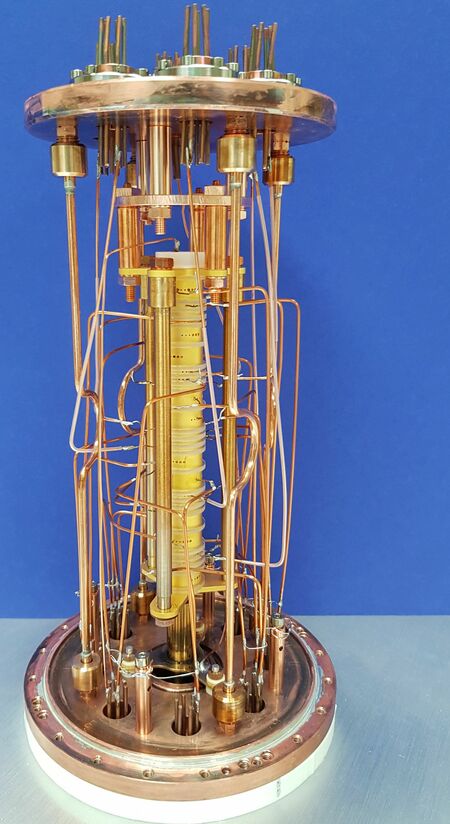What is the mass of a neutrino at rest? A team led by the department of Professor Klaus Blaum, Director at the Max Planck Institute for Nuclear Physics in Heidelberg, with the participation of Professor Christoph Düllmann's working group at Johannes Gutenberg University Mainz (JGU), GSI Helmholtzzentrum für Schwerionenforschung in Darmstadt, and the Helmholtz Institute Mainz has now made an important contribution to the "weighing" of neutrinos as part of the international ECHo collaboration. Using the Pentratrap ion trap, the researchers have achieved an extremely precise measurement of the change in mass of the holmium-163 ion when its nucleus captures an electron and becomes dysprosium-163. From this, the researchers were able to determine this so-called Q value 50 times more accurately than before. With the help of a more precise Q-value, possible systematic errors in the determination of the neutrino mass can be uncovered.
Holmium-163 is an artificial isotope that can be produced by irradiation natural erbium-162 with neutrons, which leads to erbium-163, which in turn decays into holmium-163. The chemical isolation of the produced holmium-163 was carried out at JGU, where the sample tailored to fit the requirements of the Pentatrap experiment in Heidelberg was also produced. Pentatrap consists of five so-called Penning traps. In these traps, electrically charged atoms can be trapped for long times in a combination of a static electric and magnetic field. These ions perform an intricate "circular dance", which allows their mass to be determined with extreme precision. "With an Airbus A-380 at maximum load, you could use this sensitivity to determine whether a single drop of water has landed on it," said Christoph Schweiger, PhD student in Klaus Blaum's department at the Max Planck Institute for Nuclear Physics, illustrating the capabilities of these super scales.
Publication:
C. Schweiger et al., Direct high-precision Penning-trap measurement of the Q-value of the electron capture in 163Ho for the determination of the electron neutrino mass, Nature Physics, 19 April 2024,
DOI: 10.1038/s41567-024-02461-9
Related links:
- [auf Pressemitteilung/Seite des MPIK hier verlinken]
- https://www.nuclear-chemistry.uni-mainz.de/ – Former Department of Nuclear Chemistry at Johannes Gutenberg University Mainz
- https://www.gsi.de/en/start/news – GSI Helmholtzzentrum für Schwerionenforschung
- https://www.hi-mainz.de/ – Helmholtz Institute Mainz (HIM)
Contact:
Professor Dr. Christoph E. Düllmann
Department of Chemistry – TRIGA
Johannes Gutenberg University Mainz
55099 Mainz, GERMANY
phone: +49 6131 39-25852
fax: +49 6131 39-20811
e-mail: duellmann(at)uni-mainz.de
Professor Dr. Christoph E. Düllmann
Superheavy Element Chemistry
GSI Helmholtzzentrum für Schwerionenforschung
Planckstr. 1
64291 Darmstadt
phone: +49 6159 71-2462
fax: +49 6159 71-3463
e-mail: C.E.Duellmann(at)gsi.de
https://www.gsi.de/en/start/news
Read more:
- https://press.uni-mainz.de/greetings-from-the-island-of-enhanced-stability-the-quest-for-the-limit-of-the-periodic-table/ – press release "Greetings from the island of enhanced stability: The quest for the limit of the periodic table" (13 Feb. 2024)
- https://press.uni-mainz.de/pushing-the-boundaries-of-chemistry-properties-of-heaviest-element-studied-so-far-measured-at-gsi-fair/ – press release "Pushing the boundaries of chemistry: Properties of heaviest element studied so far measured at GSI/FAIR" (15 Sept. 2022)
- https://press.uni-mainz.de/change-of-course-on-the-journey-to-the-island-of-stability/ – press release "Change of course on the journey to the island of stability" (26 Jan. 2021)
- https://press.uni-mainz.de/mainz-university-and-gsi-to-play-an-important-role-in-the-eu-funded-network-of-doctoral-students-for-research-on-radioactive-elements/ – press release "Mainz University and GSI to play an important role in the EU-funded network of doctoral students for research on radioactive elements" (3 Nov. 2020)




